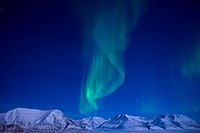
Photo from wikipedia
The Arctic has experienced prominent climate warming, at the beginning of the 20th century and currently. Comparing the driving mechanism during these periods helps to explain the causes of contemporary… Click to show full abstract
The Arctic has experienced prominent climate warming, at the beginning of the 20th century and currently. Comparing the driving mechanism during these periods helps to explain the causes of contemporary climate change. Our study explores the impact of regional circulation on Svalbard's surface air temperature (SAT, 2 m above ground). We used air temperature data from Svalbard Airport, Bjørnøya stations, and three regional circulation indices that describe the frequency of cyclonic conditions, zonal circulation, and meridional circulation. The indices were calculated for four circulation areas with differing circulation conditions and, therefore, may have various impacts on long‐term changes in SAT. This was checked for the entire study period (1920–2018), and 30‐year sub‐periods representing the most prominent climatic events: the early 20th‐century Arctic warming (ETCAW), contemporary Arctic warming (CAW), and a cold period between them (CAP). In autumn and winter, the deviations in SAT from the long‐term average during warm and cold periods were almost twice as large at Svalbard Airport as at Bjørnøya. In these seasons, the ETCAW was significantly warmer than the subsequent cold period, which was not the case for summer and spring. However, long‐term trends in the regional circulation indices were more evident in summer and spring than in autumn and winter. Air temperature was the most strongly influenced by meridional circulation over the eastern circulation areas, with the exception of spring, when air temperature variability was more affected by zonal circulation. The recent warming weakened the relationship between SAT and the indices in summer. We attributed the ETCAW in autumn to a southerly advection of sensible heat. During the same historical period, the impact of the indices was much weaker in winter. In winter during the CAP, there was a higher frequency of northern air advection, particularly over the northern part of the Greenland Sea.
Journal Title: International Journal of Climatology
Year Published: 2021
Link to full text (if available)
Share on Social Media: Sign Up to like & get
recommendations!